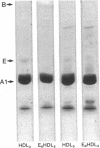Abstract
Freshly isolated human adipocytes showed specific uptake of 125I-labeled human high density lipoprotein (HDL2 and HDL3), a portion of which could be released by subsequent incubation with excess unlabeled ligand. To study the mechanism of HDL binding, sucrose gradient-purified adipocyte plasma membranes were incubated with radioiodinated lipoprotein particles under equilibrium conditions in the absence (total binding) or presence (nonspecific binding) of 100-fold excess unlabeled ligand. Specific binding of HDL2 and HDL3, calculated by subtracting nonspecific from total binding, was Ca++ independent, unaffected by EDTA, and not abolished by pronase treatment of the membranes. Modification of HDL3 by reductive methylation or cyclohexanedione treatment also failed to affect its binding to adipocyte plasma membranes. High salt concentration (200 mM NaCl) inhibited specific binding of HDL2 and HDL3 but had no effect on LDL binding. A significant portion of 125I-HDL2 or 125I-HDL3 binding was consistently inhibited by adding excess unlabeled LDL, but this inhibition was incomplete as compared with a similar molar excess of unlabeled HDL2 or HDL3. The role of apoproteins (apo) in HDL binding to adipocyte membranes was examined by comparing binding of HDL2 and HDL3 isolated from normal, abetalipoproteinemic (abeta) and apo E-deficient (apo E0) plasma. Specific binding was observed with all normal and mutant HDL particles. Furthermore, a significant portion (61-78%) of abeta-HDL2, apo E0-HDL2, and apo E0-HDL3 binding was inhibited by adding 100-fold excess of unlabeled low density lipoproteins (LDL). The cross-competition of LDL and HDL binding was confirmed by the ability of normal, abeta, and apo E0-HDL2 to completely inhibit 125I-LDL binding. These data suggest that HDL binding is independent of apo E and that the responsible apoprotein(s) of HDL complete with LDL-apo B for binding to the same or closely related site in the adipocyte plasma membrane. Normal and apo E0-HDL3 binding was also completely inhibited by normal HDL2, which suggested that HDL2 and HDL3 probably bind to the same site. Scatchard analysis of normal HDL2, normal HDL3, and apo E0-HDL3 binding data best fitted a one-component binding profile with similar equilibrium dissociation constants (40-96 nM). HDL3 binding was found to be effectively inhibited by anti-human apo AI or anti-human apo AII, but not by anti-human apo B antisera. This binding was also unaffected by monoclonal anti-human apo B or E antibodies known to inhibit binding of apo B or apo E containing lipoprotein to the LDL receptor of cultured fibroblasts. These findings, taken together, suggest that human fat cells possess HDL binding sites with apo AI and /or apo AII specificity. The significant but partial inhibition of HDL2 and HDL3 binding by LDL along with the complete inhibition of LDL binding by HDL2 and HDL3 tends to exclude a single binding site that interacts both lipoproteins and favors the interpretation that LDL and HDL particles bind to multiple recognition sites or to different conformation of the same lipoprotein binding domain on the human fat cell.
Full text
PDF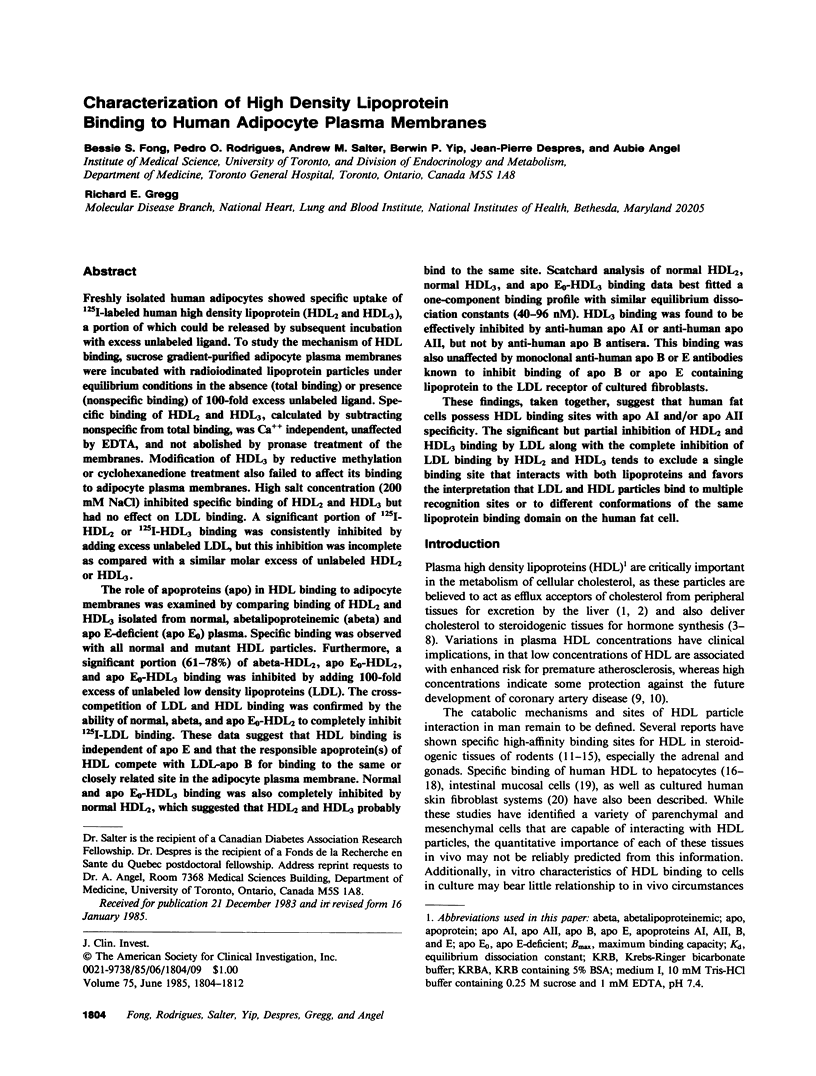
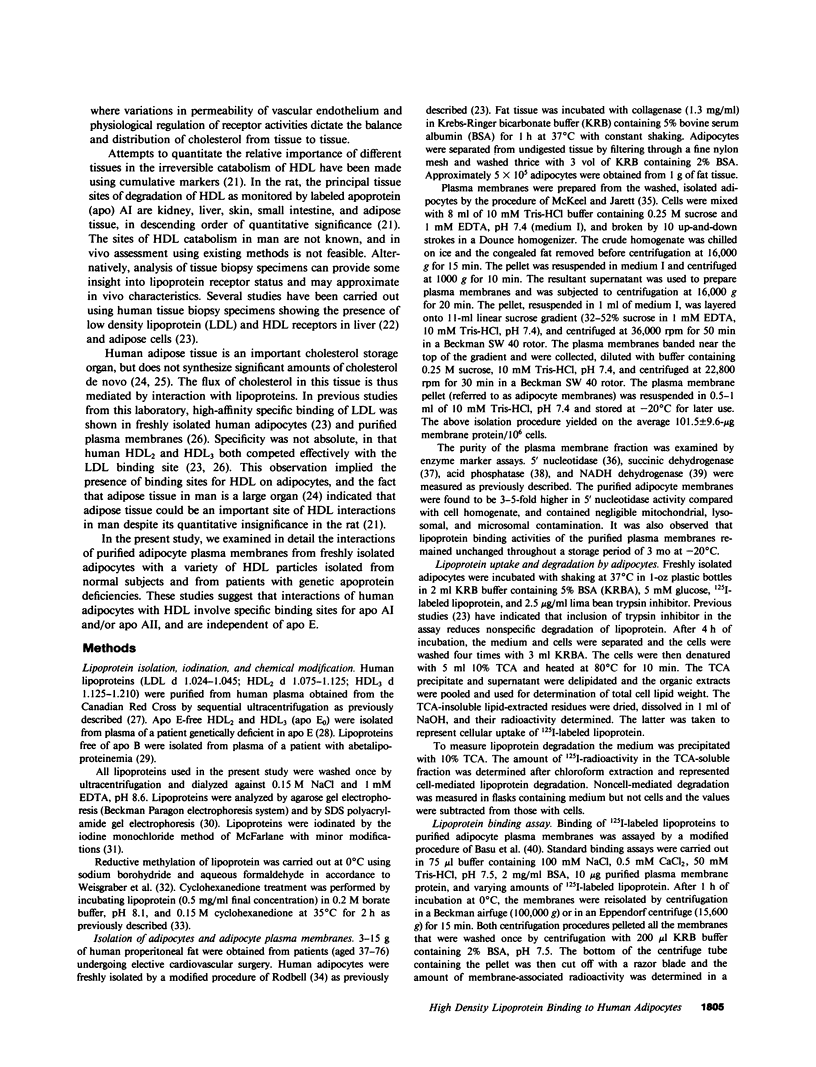
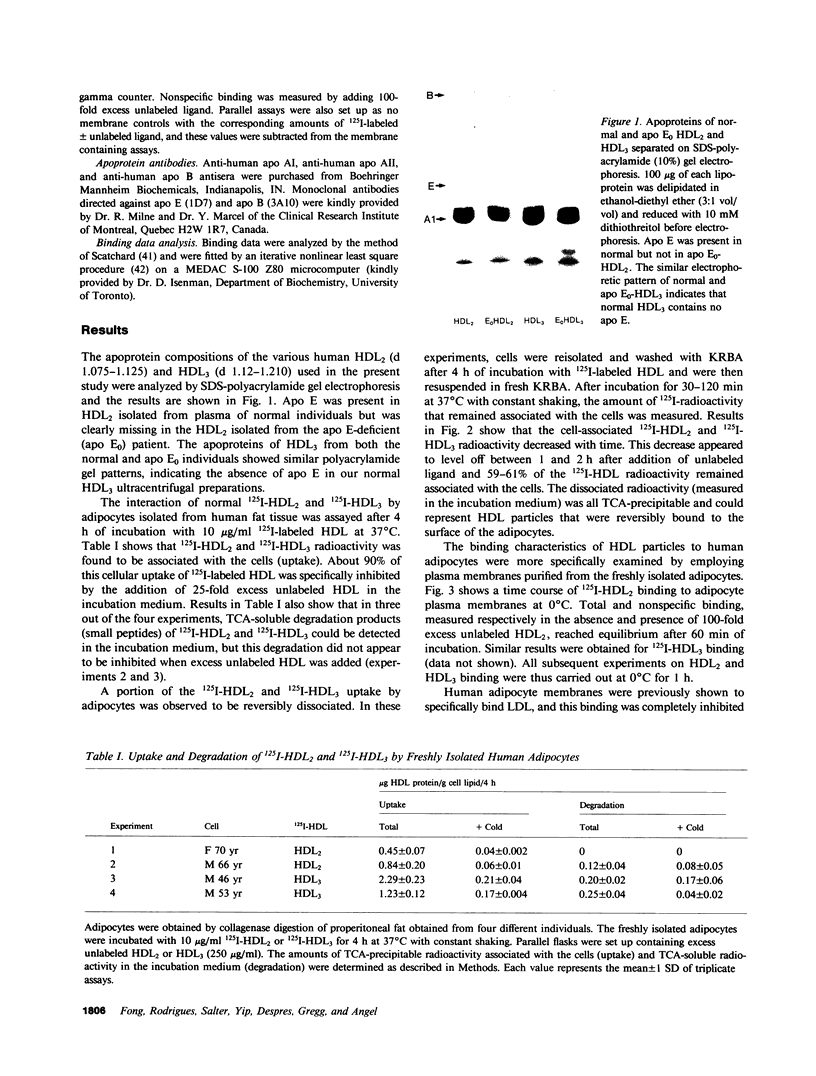
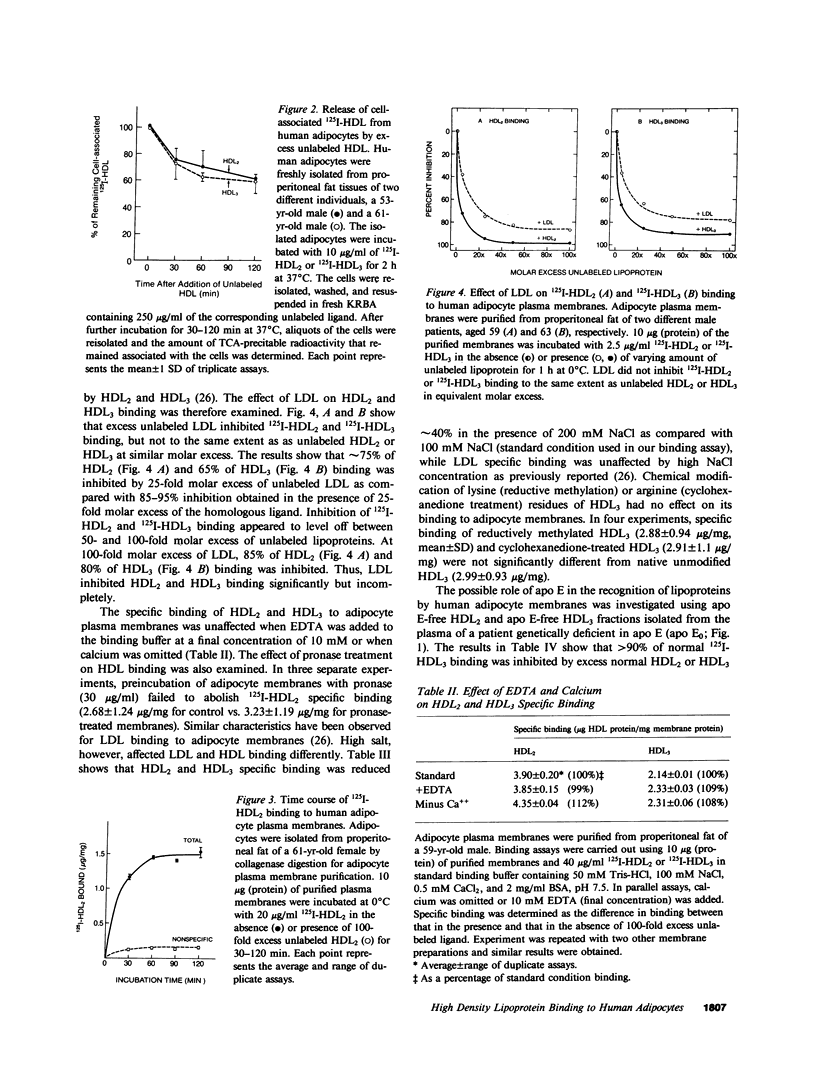

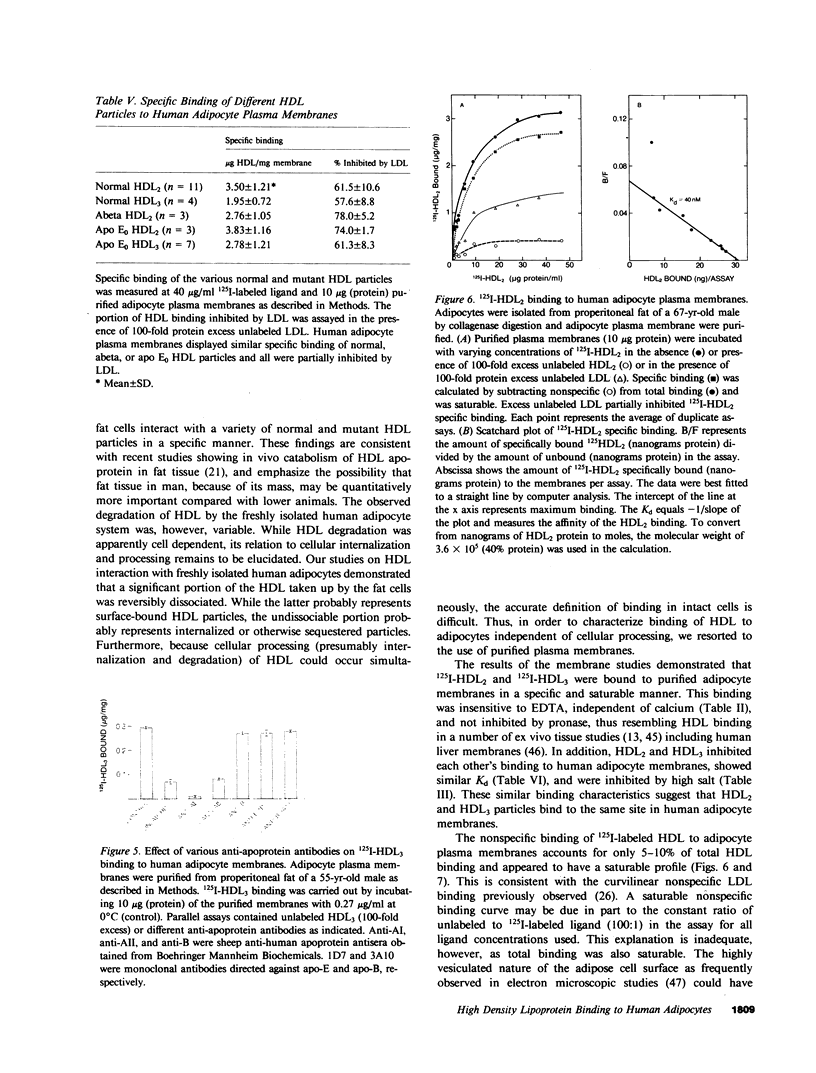
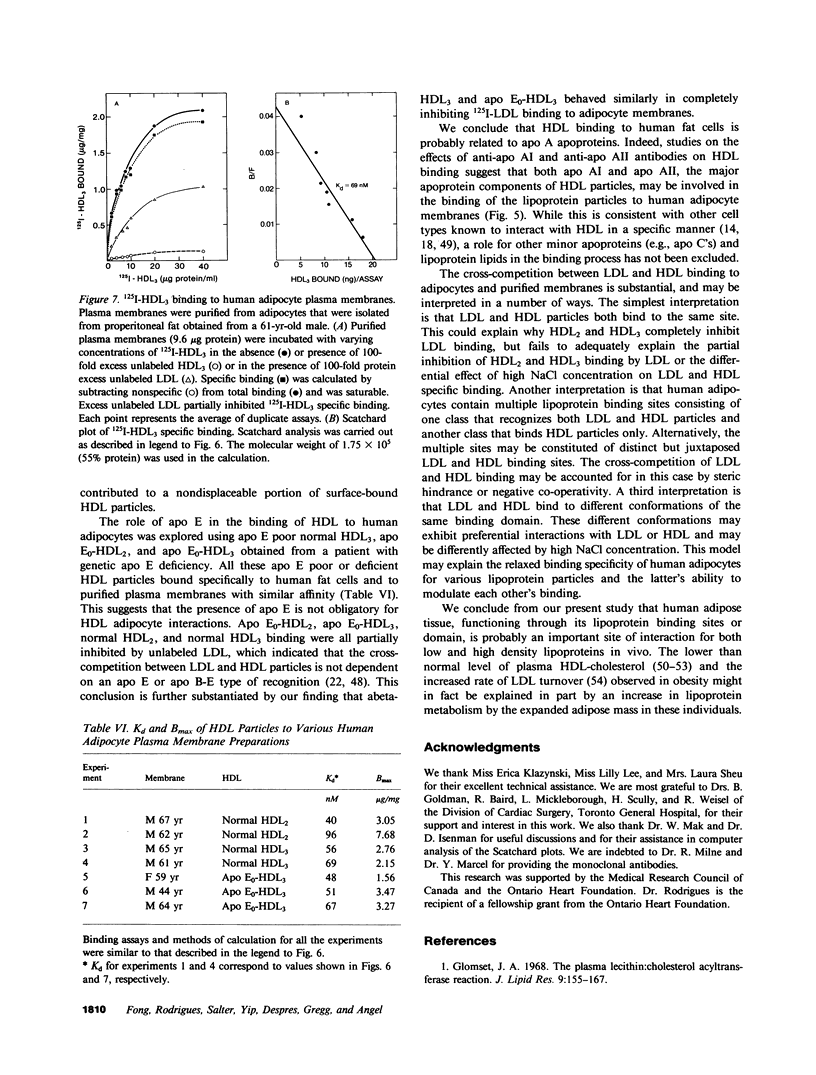
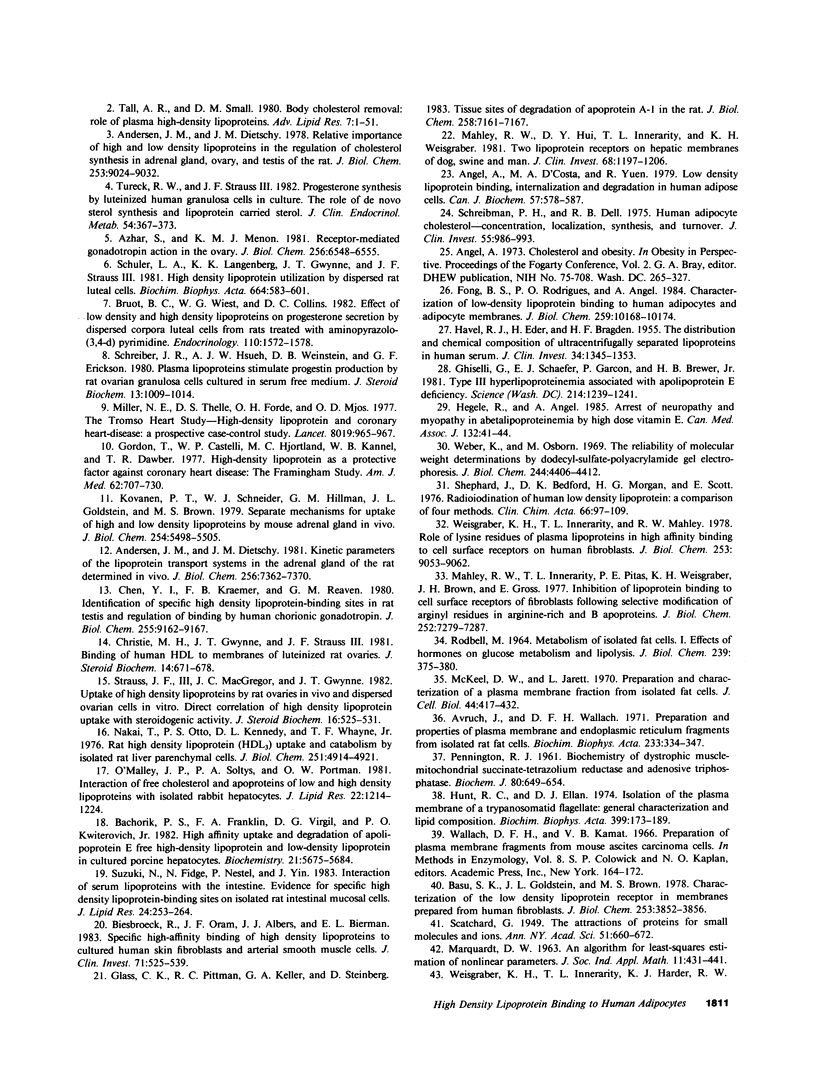
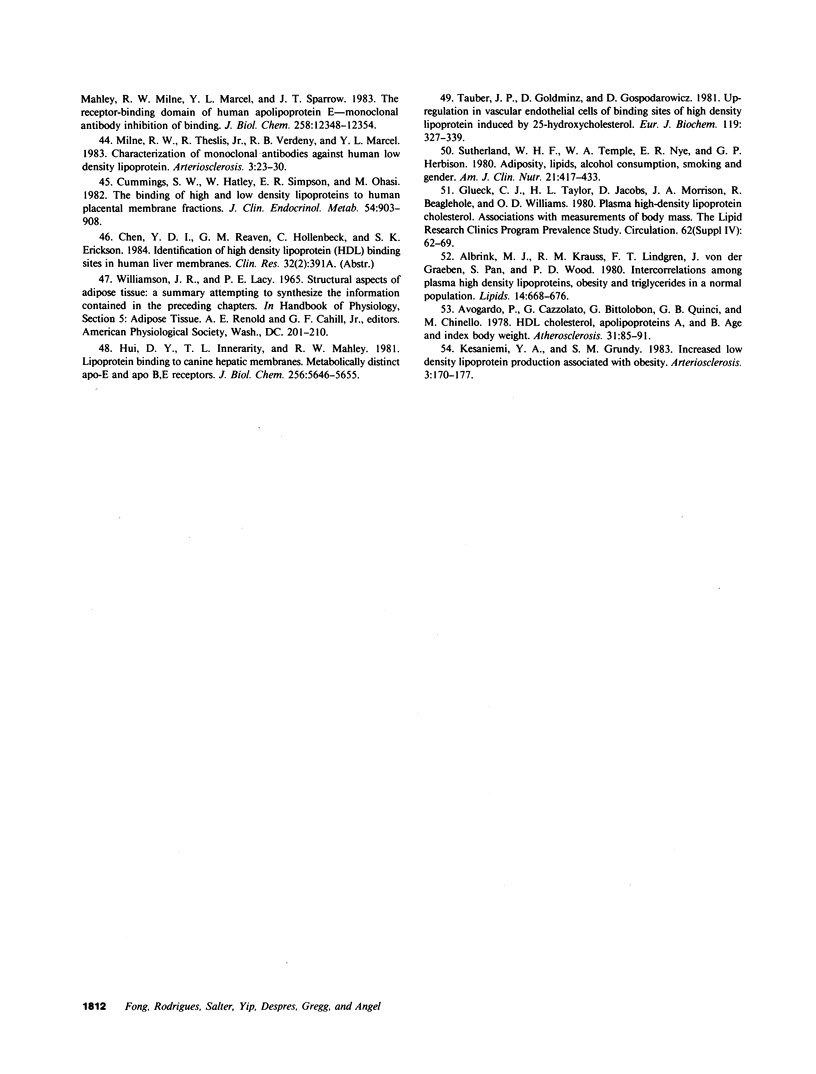
Images in this article
Selected References
These references are in PubMed. This may not be the complete list of references from this article.
- Albrink M. J., Krauss R. M., Lindgrem F. T., von der Groeben J., Pan S., Wood P. D. Intercorrelations among plasma high density lipoprotein, obesity and triglycerides in a normal population. Lipids. 1980 Sep;15(9):668–676. doi: 10.1007/BF02534017. [DOI] [PubMed] [Google Scholar]
- Andersen J. M., Dietschy J. M. Kinetic parameters of the lipoprotein transport systems in the adrenal gland of the rat determined in vivo. Comparison of low and high density lipoproteins of human and rat origin. J Biol Chem. 1981 Jul 25;256(14):7362–7370. [PubMed] [Google Scholar]
- Andersen J. M., Dietschy J. M. Relative importance of high and low density lipoproteins in the regulation of cholesterol synthesis in the adrenal gland, ovary, and testis of the rat. J Biol Chem. 1978 Dec 25;253(24):9024–9032. [PubMed] [Google Scholar]
- Angel A., D'Costa M. A., Yuen R. Low density lipoprotein binding, internalization, and degradation in human adipose cells. Can J Biochem. 1979 Jun;57(6):578–587. doi: 10.1139/o79-073. [DOI] [PubMed] [Google Scholar]
- Avogaro P., Cazzolato G., Bittolo Bon G., Quinci G. B., Chinello M. HDL-cholesterol, apolipoproteins A1 and B. Age and index body weight. Atherosclerosis. 1978 Sep;31(1):85–91. doi: 10.1016/0021-9150(78)90040-0. [DOI] [PubMed] [Google Scholar]
- Avruch J., Wallach D. F. Preparation and properties of plasma membrane and endoplasmic reticulum fragments from isolated rat fat cells. Biochim Biophys Acta. 1971 Apr 13;233(2):334–347. doi: 10.1016/0005-2736(71)90331-2. [DOI] [PubMed] [Google Scholar]
- Azhar S., Menon K. M. Receptor-mediated gonadotropin action in the ovary. Rat luteal cells preferentially utilize and are acutely dependent upon the plasma lipoprotein-supplied sterols in gonadotropin-stimulated steroid production. J Biol Chem. 1981 Jul 10;256(13):6548–6555. [PubMed] [Google Scholar]
- Bachorik P. S., Franklin F. A., Virgil D. G., Kwiterovich P. O., Jr High-affinity uptake and degradation of apolipoprotein E free high-density lipoprotein and low-density lipoprotein in cultured porcine hepatocytes. Biochemistry. 1982 Oct 26;21(22):5675–5684. doi: 10.1021/bi00265a044. [DOI] [PubMed] [Google Scholar]
- Basu S. K., Goldstein J. L., Brown M. S. Characterization of the low density lipoprotein receptor in membranes prepared from human fibroblasts. J Biol Chem. 1978 Jun 10;253(11):3852–3856. [PubMed] [Google Scholar]
- Biesbroeck R., Oram J. F., Albers J. J., Bierman E. L. Specific high-affinity binding of high density lipoproteins to cultured human skin fibroblasts and arterial smooth muscle cells. J Clin Invest. 1983 Mar;71(3):525–539. doi: 10.1172/JCI110797. [DOI] [PMC free article] [PubMed] [Google Scholar]
- Bruot B. C., Wiest W. G., Collins D. C. Effect of low density and high density lipoproteins on progesterone secretion by dispersed corpora luteal cells from rats treated with aminopyrazolo-(3,4-d)pyrimidine. Endocrinology. 1982 May;110(5):1572–1578. doi: 10.1210/endo-110-5-1572. [DOI] [PubMed] [Google Scholar]
- Chen Y. D., Kraemer F. B., Reaven G. M. Identification of specific high density lipoprotein-binding sites in rat testis and regulation of binding by human chorionic gonadotropin. J Biol Chem. 1980 Oct 10;255(19):9162–9167. [PubMed] [Google Scholar]
- Christie M. H., Gwynne J. T., Strauss J. F., 3rd Binding of human high density lipoproteins to membranes of luteinized rat ovaries. J Steroid Biochem. 1981 Aug;14(8):671–678. doi: 10.1016/0022-4731(81)90001-7. [DOI] [PubMed] [Google Scholar]
- Cummings S. W., Hatley W., Simpson E. R., Ohashi M. The binding of high and low density lipoproteins to human placental membrane fractions. J Clin Endocrinol Metab. 1982 May;54(5):903–908. doi: 10.1210/jcem-54-5-903. [DOI] [PubMed] [Google Scholar]
- Fong B. S., Rodrigues P. O., Angel A. Characterization of low density lipoprotein binding to human adipocytes and adipocyte membranes. J Biol Chem. 1984 Aug 25;259(16):10168–10174. [PubMed] [Google Scholar]
- Ghiselli G., Schaefer E. J., Gascon P., Breser H. B., Jr Type III hyperlipoproteinemia associated with apolipoprotein E deficiency. Science. 1981 Dec 11;214(4526):1239–1241. doi: 10.1126/science.6795720. [DOI] [PubMed] [Google Scholar]
- Glass C. K., Pittman R. C., Keller G. A., Steinberg D. Tissue sites of degradation of apoprotein A-I in the rat. J Biol Chem. 1983 Jun 10;258(11):7161–7167. [PubMed] [Google Scholar]
- Glomset J. A. The plasma lecithins:cholesterol acyltransferase reaction. J Lipid Res. 1968 Mar;9(2):155–167. [PubMed] [Google Scholar]
- Glueck C. J., Taylor H. L., Jacobs D., Morrison J. A., Beaglehole R., Williams O. D. Plasma high-density lipoprotein cholesterol: association with measurements of body mass. The Lipid Research Clinics Program Prevalence Study. Circulation. 1980 Nov;62(4 Pt 2):IV–62-9. [PubMed] [Google Scholar]
- Gordon T., Castelli W. P., Hjortland M. C., Kannel W. B., Dawber T. R. High density lipoprotein as a protective factor against coronary heart disease. The Framingham Study. Am J Med. 1977 May;62(5):707–714. doi: 10.1016/0002-9343(77)90874-9. [DOI] [PubMed] [Google Scholar]
- HAVEL R. J., EDER H. A., BRAGDON J. H. The distribution and chemical composition of ultracentrifugally separated lipoproteins in human serum. J Clin Invest. 1955 Sep;34(9):1345–1353. doi: 10.1172/JCI103182. [DOI] [PMC free article] [PubMed] [Google Scholar]
- Hegele R. A., Angel A. Arrest of neuropathy and myopathy in abetalipoproteinemia with high-dose vitamin E therapy. Can Med Assoc J. 1985 Jan 1;132(1):41–44. [PMC free article] [PubMed] [Google Scholar]
- Hui D. Y., Innerarity T. L., Mahley R. W. Lipoprotein binding to canine hepatic membranes. Metabolically distinct apo-E and apo-B,E receptors. J Biol Chem. 1981 Jun 10;256(11):5646–5655. [PubMed] [Google Scholar]
- Kesaniemi Y. A., Grundy S. M. Increased low density lipoprotein production associated with obesity. Arteriosclerosis. 1983 Mar-Apr;3(2):170–177. doi: 10.1161/01.atv.3.2.170. [DOI] [PubMed] [Google Scholar]
- Kovanen P. T., Schneider W. J., Hillman G. M., Goldstein J. L., Brown M. S. Separate mechanisms for the uptake of high and low density lipoproteins by mouse adrenal gland in vivo. J Biol Chem. 1979 Jun 25;254(12):5498–5505. [PubMed] [Google Scholar]
- Mahley R. W., Hui D. Y., Innerarity T. L., Weisgraber K. H. Two independent lipoprotein receptors on hepatic membranes of dog, swine, and man. Apo-B,E and apo-E receptors. J Clin Invest. 1981 Nov;68(5):1197–1206. doi: 10.1172/JCI110365. [DOI] [PMC free article] [PubMed] [Google Scholar]
- Mahley R. W., Innerarity T. L., Pitas R. E., Weisgraber K. H., Brown J. H., Gross E. Inhibition of lipoprotein binding to cell surface receptors of fibroblasts following selective modification of arginyl residues in arginine-rich and B apoproteins. J Biol Chem. 1977 Oct 25;252(20):7279–7287. [PubMed] [Google Scholar]
- McKeel D. W., Jarett L. Preparation and characterization of a plasma membrane fraction from isolated fat cells. J Cell Biol. 1970 Feb;44(2):417–432. doi: 10.1083/jcb.44.2.417. [DOI] [PMC free article] [PubMed] [Google Scholar]
- Miller N. E., Thelle D. S., Forde O. H., Mjos O. D. The Tromsø heart-study. High-density lipoprotein and coronary heart-disease: a prospective case-control study. Lancet. 1977 May 7;1(8019):965–968. doi: 10.1016/s0140-6736(77)92274-7. [DOI] [PubMed] [Google Scholar]
- Milne R. W., Theolis R., Jr, Verdery R. B., Marcel Y. L. Characterization of monoclonal antibodies against human low density lipoprotein. Arteriosclerosis. 1983 Jan-Feb;3(1):23–30. doi: 10.1161/01.atv.3.1.23. [DOI] [PubMed] [Google Scholar]
- Nakai T., Otto P. S., Kennedy D. L., Whayne T. F., Jr Rat high density lipoprotein subfraction (HDL3) uptake and catabolism by isolated rat liver parenchymal cells. J Biol Chem. 1976 Aug 25;251(16):4914–4921. [PubMed] [Google Scholar]
- O'Malley J. P., Soltys P. A., Portman O. W. Interaction of free cholesterol and apoproteins of low and high density lipoproteins with isolated rabbit hepatocytes. J Lipid Res. 1981 Nov;22(8):1214–1224. [PubMed] [Google Scholar]
- PENNINGTON R. J. Biochemistry of dystrophic muscle. Mitochondrial succinate-tetrazolium reductase and adenosine triphosphatase. Biochem J. 1961 Sep;80:649–654. doi: 10.1042/bj0800649. [DOI] [PMC free article] [PubMed] [Google Scholar]
- RODBELL M. METABOLISM OF ISOLATED FAT CELLS. I. EFFECTS OF HORMONES ON GLUCOSE METABOLISM AND LIPOLYSIS. J Biol Chem. 1964 Feb;239:375–380. [PubMed] [Google Scholar]
- Schreiber J. R., Hsueh A. J., Weinstein D. B., Erickson G. F. Plasma lipoproteins stimulate progestin production by rat ovarian granulosa cells cultured in serum free medium. J Steroid Biochem. 1980 Sep;13(9):1009–1014. doi: 10.1016/0022-4731(80)90130-2. [DOI] [PubMed] [Google Scholar]
- Schreibman P. H., Dell R. B. Human adipocyte cholesterol. Concentration, localization, synthesis, and turnover. J Clin Invest. 1975 May;55(5):986–993. doi: 10.1172/JCI108028. [DOI] [PMC free article] [PubMed] [Google Scholar]
- Schuler L. A., Langenberg K. K., Gwynne J. T., Strauss J. F., 3rd High density lipoprotein utilization by dispersed rat luteal cells. Biochim Biophys Acta. 1981 Jun 23;664(3):583–601. doi: 10.1016/0005-2760(81)90135-1. [DOI] [PubMed] [Google Scholar]
- Shepherd J., Bedford D. K., Morgan H. G. Radioiodination of human low density lipoprotein: a comparison of four methods. Clin Chim Acta. 1976 Jan 2;66(1):97–109. doi: 10.1016/0009-8981(76)90376-4. [DOI] [PubMed] [Google Scholar]
- Strauss J. F., 3rd, MacGregor L. C., Gwynne J. T. Uptake of high density lipoproteins by rat ovaries in vivo and dispersed ovarian cells in vitro. Direct correlation of high density lipoprotein uptake with steroidogenic activity. J Steroid Biochem. 1982 Apr;16(4):525–531. doi: 10.1016/0022-4731(82)90074-7. [DOI] [PubMed] [Google Scholar]
- Suzuki N., Fidge N., Nestel P., Yin J. Interaction of serum lipoproteins with the intestine. Evidence for specific high density lipoprotein-binding sites on isolated rat intestinal mucosal cells. J Lipid Res. 1983 Mar;24(3):253–264. [PubMed] [Google Scholar]
- Tall A. R., Small D. M. Body cholesterol removal: role of plasma high-density lipoproteins. Adv Lipid Res. 1980;17:1–51. [PubMed] [Google Scholar]
- Tauber J. P., Goldminz D., Gospodarowicz D. Up-regulation in vascular endothelial cells of binding sites of high density lipoprotein induced by 25-hydroxycholesterol. Eur J Biochem. 1981 Oct;119(2):327–339. doi: 10.1111/j.1432-1033.1981.tb05612.x. [DOI] [PubMed] [Google Scholar]
- Tureck R. W., Strauss J. F., 3rd Progesterone synthesis by luteinized human granulosa cells in culture: the role of de novo sterol synthesis and lipoprotein-carried sterol. J Clin Endocrinol Metab. 1982 Feb;54(2):367–373. doi: 10.1210/jcem-54-2-367. [DOI] [PubMed] [Google Scholar]
- Weber K., Osborn M. The reliability of molecular weight determinations by dodecyl sulfate-polyacrylamide gel electrophoresis. J Biol Chem. 1969 Aug 25;244(16):4406–4412. [PubMed] [Google Scholar]
- Weisgraber K. H., Innerarity T. L., Harder K. J., Mahley R. W., Milne R. W., Marcel Y. L., Sparrow J. T. The receptor-binding domain of human apolipoprotein E. Monoclonal antibody inhibition of binding. J Biol Chem. 1983 Oct 25;258(20):12348–12354. [PubMed] [Google Scholar]
- Weisgraber K. H., Innerarity T. L., Mahley R. W. Role of lysine residues of plasma lipoproteins in high affinity binding to cell surface receptors on human fibroblasts. J Biol Chem. 1978 Dec 25;253(24):9053–9062. [PubMed] [Google Scholar]



